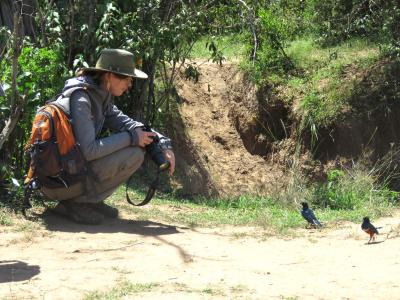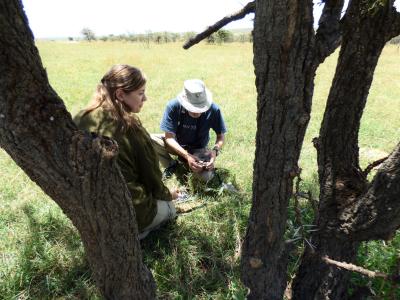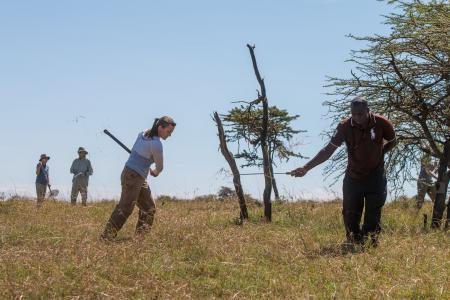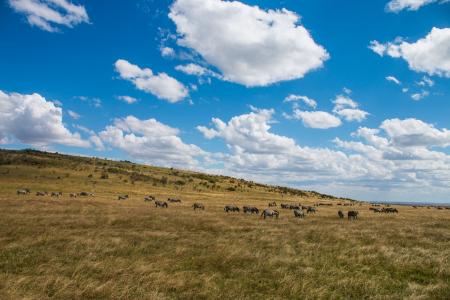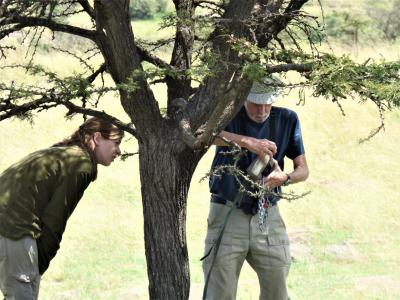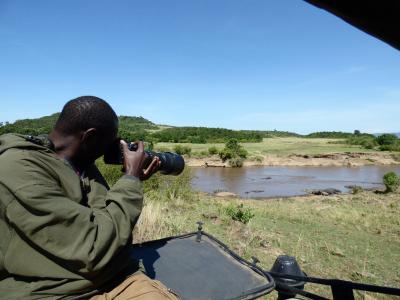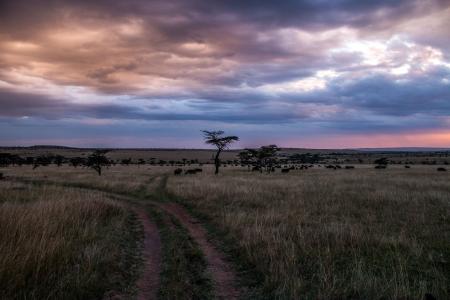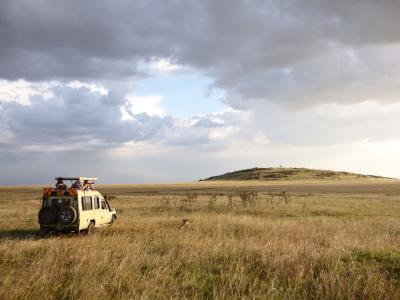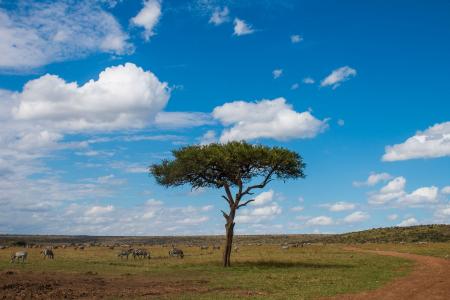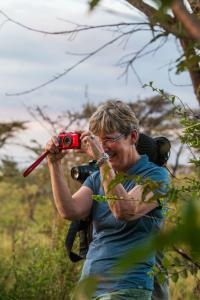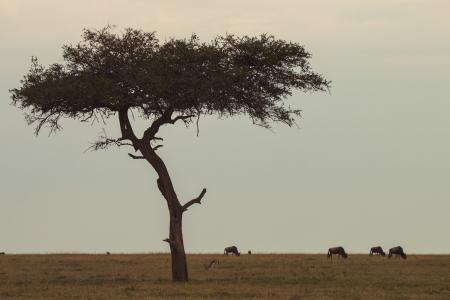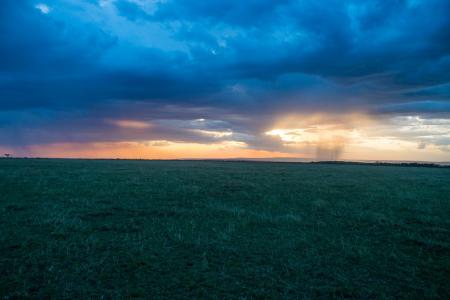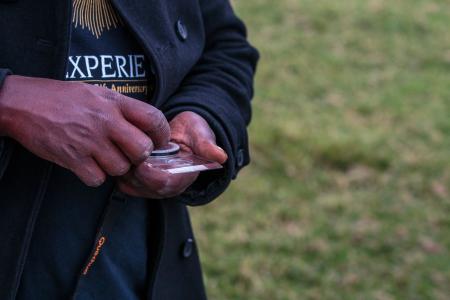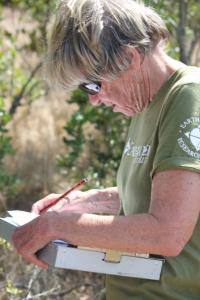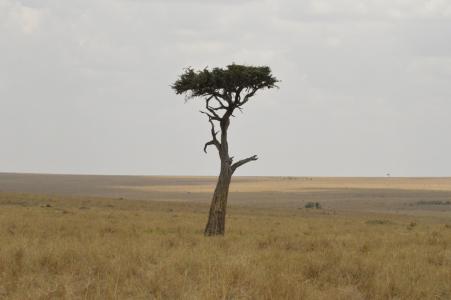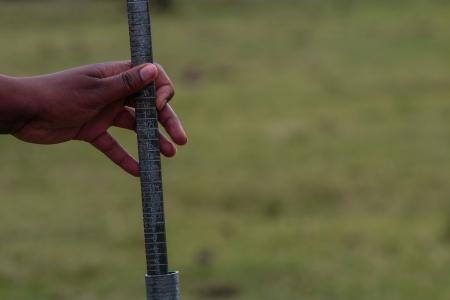The Research
On this expedition, you’ll participate in research that attempts to positively influence populations of diminishing African savanna wild herbivores through the controlled use of cattle grazing. African savannas rely on grazing by large mammalian herbivores to create and maintain their characteristic tree-grass mixtures. In the Greater Mara Ecosystem, Kenya, domestic cattle graze alongside wild ungulates like elephants, giraffes, zebras, and many species of antelopes. Here, landowners that have leased their land to the conservancies and their livestock share the landscape with wildlife. By leasing land parcels from landowners, land is secured for wildlife rather than human settlement. These efforts restore biodiversity, which are measured by: amount of land under conservation, the increase in and return of wildlife, and public support for conservation
With wildlife tourism generating revenue for Maasai Mara communities, many conservancy managers and landowners are faced with the challenge of maintaining viable populations of large carnivores and their prey, all the while wanting to protect their livestock interests and investments. Lions and other large carnivores are particularly appealing to tourists, and require conservation in a manner that minimizes livestock losses—a major source of income for the local communities. Earthwatch scientists Caroline Ng’weno, Martin Mulama, and Jake Goheen have devised an experimental approach, which will attempt to achieve this goal.
Research Aims
Herbivores like cattle, zebras, and species with more fragile populations, help maintain a mix of trees and grasses on the savanna. Large herbivores maintain savanna ecosystems by allowing both trees and grasses to thrive. Previous observations suggest that zebras have a fondness for areas where cattle have grazed. But can cattle actually attract zebra? The data you collect on herbivore abundance can help answer this question.
Researchers also already know that zebras are the most common lion meal. So the next question is: do lions and other predators that eat zebras hunt where these striped ungulates are most abundant, or where prey of all kinds is easiest to catch? If it’s the former, as these researchers suspect, lions should follow the zebras to those greener, former cattle pastures.
If the first two hypotheses turn out to be true—that zebras follow cattle and predators follow zebras—one question still remains—will moving cattle strategically to attract zebras help reduce the risk of lion predation on the more rare herbivores (hartebeest and topi)? This could be possible: the declining species tend to congregate in smaller, more sedentary herds than zebras, which makes them easier to catch than zebras if they’re in the same area.
You can provide the observational power to discover how this experiment will actually unfold. Help be part of a strategy that could strengthen predators, prey, and the people of Kenya who depend on tourism and livestock.
How You Will Help
You will have the opportunity to participate in a unique experiment at the Olare Motorogi Conservancy (OMC) in Maasai Mara, Kenya. Your research tasks will include:
- Opportunistic Lion Surveys: Lions in Maasai Mara are easy to locate via opportunistic sightings, so unlike our previous site, we do not plan to collar lions in the Mara as our team already has a clear understanding on pride home ranges. The opportunistic sighting data will facilitate the understanding of pride dynamics, resource use, movement ecology and connectivity. Additionally, the collated data will be used to investigate dispersal in lions. Understanding dispersal of large carnivores from protected areas into surrounding landscapes is critical to their conservation in an increasingly fragmented landscape. In the meantime, we are working closely with OMC rangers and guides within the conservancy to collate a detailed database of lion prides within the conservancy based on these opportunistic sightings and with volunteer support, this will help enrich our existing database.
- Predation Site Investigation—Kill Sites: We will record any opportunistic kill site we come a cross during field work. The kill site sighting data points will be used remotely in spatial analysis to identify landscape features that are associated with locations of where specific large carnivores (lions, cheetahs and wild dogs) are likely to kill their prey. Volunteers will only record the GPS coordinate and also identify the prey species killed. Please note this is an opportunistic sighting and hence some teams might not get a chance to record the data. However, our research team collates the data from a comprehensive database existing at OMC, whereby rangers record kills during their routine patrols.
- Characterize Boma Sites: Volunteers will also help to find and characterize glades: nutrient-rich hotspots derived from abandoned bomas (“boma” refers to actively used cattle corrals) that attract wild ungulates. Bomas receive a concentration of nutrients from cattle dung, subsequently promoting more grass than non-boma areas. Data collected will facilitate a better understanding of whether zebras or other key lion prey are attracted to bomas, and in turn, whether lions follow zebra to their feeding grounds.
- Pride Monitoring: Despite being one of the most iconic ecosystems on earth, little research has been carried out on large predators in the Mara. Therefore, the volunteers will help support OMC rangers in this vital monitoring. While carrying out scheduled activities, volunteers are encouraged to record all sightings of large predators, and take quality photos to help in creating OMC lion profiles. Individual lions can be identified by ear tags, scar patterns, and the patterns of their whiskers. Photos can be compared to our growing database of known lions to help identify individuals, as well as movement between prides. The robust dataset will also be used to assess population demographics, distribution and trends of these charismatic species.
- Herbivore Distance Sampling Survey: You will locate lion prey on the eight predetermined transects from ground surveys. Using binoculars, GPS, compass and laser rangefinder, you will record species, age and sex structure of herds to understand the density and spatial distribution of large carnivore prey.
- Camera Trapping of Large Carnivores: Except for lions and hyenas, other large carnivores like wild dogs and leopards are elusive and occur in lower densities. Therefore, we will install infrared, motion-sensitive cameras to monitor them. You will help deploy and service the camera traps in the field and later download and inspect these images to match the animals to individuals in the field database. You will also help with general data entry, and review camera trap photos each day. Please note that this will be done during the short drives at established grids in Oloisukut conservancy which is only a 30 minute drive to the field site.
- Kids for Conservation: We understand that our neighboring communities are the most significant stakeholders in our predator conservation efforts. As such, we are committed in promoting conservation education. Together with Garden Cottage we have set aside a special day to engage with kids supported by the facility through their established Shiners readers club. The club engages kids of ages between 4 - 12 years in a reading club as away of building capacity of the young learners. We will schedule one of the weekends that the club meets to raise awareness of the plight of large carnivores. During the set day, we will also interact with and inspire the children on the value of conserving wildlife through sharing fun facts about wildlife and also engage in interactive games. We encourage the volunteers to bring their energy in organizing outdoor games and other competitive games with conservation themes. Through such an initiative, the children will become ambassadors to the local communities given change in mindset following understanding of our conservation efforts. In the past some previous volunteers have chosen to bring with them pens, pencils, notebooks and story books which we use as prizes for children who take part in the activities. Other books and fun activity resources are also provided by Garden Cottages. In the previous teams with proper planning of logistics with the PI we have picked items from Nairobi given the luggage restriction in the flights to Mara.
Life in the Field
You’ll spend your days in the midst of the wildlife-rich conservancy, observing zebras and other herbivores and large carnivores. As cattle grazing spots are established and moved around, your team will follow the herds to assess if and how the composition of animals around them changes. You’ll also traverse the conservancy to set up and collect camera traps, which capture images of predators and other animals that pass by them. You can expect to walk around two kilometers (1.2 miles) a day, always accompanied by an OMC ranger. Hiking will primarily take place during camera trap activities.
You’ll also spend some time at Garden Cottages entering data from your lion sightings, boma surveys, and herbivore demography. On many evenings you’ll have free hours to enjoy extra activities including; sorting camera trap images, bonfire discussions, sundowners at the Garden Cottage lobby, and movie nights based on wildlife documentaries. All these are a bid to learn more about the research and experience the amazing culture and diversity within the study site.
ITINERARY
Weather and research needs can lead to changes in the daily schedule. We appreciate your cooperation and understanding.
- Day 1: Arrival
- Meet team members at Kichwa Tembo airstrip, drive to Garden Cottages, and settle into accommodations.
- Day 2: Introduction and Training
- Comprehensive safety briefing, introduction to research with hands on training (distance sampling, camera traps, data entry, and large predator identification).
- Days 3–13: Fieldwork
- In the field, you will monitor large herbivores, predators and record data, monitor hartebeest demography, deploy and service camera traps and dung surveys at abandoned livestock corrals (bomas) within the conservancy. You’ll also enjoy one full recreational day during this period. The recreational day will consist of either a visit to Maasai Mara Game Reserve/ Mara River or relaxing at the camp (NOTE: you will need to plan for your own transport. The field staff will be available to assist with planning, the cost $150 per person which includes gate entry and transport).
- Day 14:
- Depart Mara in the morning based on travel itinerary to Kichwa Tembo Airstrip.
Accommodations and Food
* Please note that not every expedition has couples’ or single's accommodations available. Please call or email Earthwatch to check for availability prior to reserving your space(s) on the team.
SLEEPING
Accommodations will be at Garden Cottages located about 2–3 hours drive to Olare Motorogi (field site). This is about a 4–5 hours round trip. We understand this represents a significant amount of time in the project vehicles over bumpy roads. This affords many opportunities to see the Maasai Mara‘s wildlife and experience the effects of anthropogenic influences on wildlife conservation areas. We have also decided to alternate days between visiting the closer and more distant sites to allow sufficient resting.
Garden Cottages is an eco friendly camp adjoining the Oloisukut Conservancy and Maasai Mara National Reserve. All rooms are fitted with comfortable beds. Bedding and towels are provided and washing of bedding and towels is done every three days. Personal laundry is done by request for a cost of 500 Kenyan Shillings per load (this cost may change depending on changes in price inflation). If interested in using this service, you will need to complete a laundry form that will be provided at the main sitting area of the accommodations. Staff will not wash socks or underwear, but volunteers can do so on their own during free time. Laundry is payable on departure. The accommodations are occupied by only the Earthwatch volunteers and field staff throughout the course of your stay.
All volunteers are guaranteed a single room, however bathrooms are shared. NOTE: Special room requests cannot be accommodated.
* Earthwatch will honor each person’s assertion of gender identity, respectfully and without judgement. For both teen and adult teams, where logistics dictate single-sex accommodations or other facilities, participant placements will be made in accordance with the gender identity the participant specified on their Earthwatch Participant form and/or preferences indicated in discussions with Earthwatch.
BATHROOMS
All the houses have bathrooms ensuite with flush toilets and showers with hot water throughout the day. The washrooms are shared between three people within the same house unit. There are no restrictions on the number of showers that a volunteer can take, but all are encouraged to conserve water and energy. Volunteers need to bring their own soap, shampoo, and other personal toiletries.
ELECTRICITY
Electricity is provided at the cottages, however due to frequent power outages the facility has a backup generator. We ask volunteers to be conscious of their power use. The Garden Cottages outlets are 240 volt (U.K. plugs with three flat prongs- type G). All electronic appliances, including laptops, camera batteries, etc. can be charged at the dining area. We recommend bringing an adapter/converter to prevent power surges, (e.g. for U.S. electronics that run on 120 volts).
PERSONAL COMMUNICATIONS
Wi-Fi is not available at the accommodations, and phone reception is limited and occasionally unavailable.
Family and friends of volunteers should note that personal communication is not always possible while volunteers are on an expedition. Should someone need to contact you urgently from the field, they will need to contact the Earthwatch 24-hour emergency line for assistance (number located at end of briefing).
DISTANCE TO THE FIELD SITE
The field site is approximately a 2–3 hours drive on conservancy lands just north of the Maasai Mara National Park. This makes for about a 4–5 hour drive round trip (though some days will be shorter 1.5–2.5 hours round trip).
FOOD AND WATER
A chef will prepare hot meals, with breakfast and dinner mostly served at the Cottage dining area. Packed lunches will be prepared before heading into the field each day as the drive and fieldwork will extend through the afternoon. The chef will oversee all arrangements, but in case of special dietary needs you may need to help the chef with either food preparation, or preparation of a menu that works for you.
The following are examples of foods you may find in the field. Variety depends on availability. We appreciate your flexibility.
- Breakfast: Eggs (scrambled or fried), bacon, toast, fruits, cereals, juice, tea, and coffee.
- Lunch: Packed sandwiches, fruit and snacks. On some days, Kenyan menu of beans, stews, vegetables and ugali, and chapati.
- Dinner: Pasta and sauce, roasted chicken and vegetables, curry, chapati and beans, fresh fruit, and a variety of local Kenyan food will be available after fieldwork.
- Snacks: Chips and crackers
- Beverages: Water is available in a water dispenser at the dining area. Tea and coffee are also available throughout the day.
SPECIAL DIETARY REQUIREMENTS
Please alert Earthwatch to any special dietary requirements (e.g., diabetes, lactose intolerance, nut or other food allergies, vegetarian or vegan diets) as soon as possible, and note them in the space provided on your volunteer forms.
Vegetarian diets can be accommodated on this expedition. Unfortunately we cannot accommodate other dietary restrictions.
Project Conditions
The information that follows is as accurate as possible, but please keep in mind that conditions may change.
Maasai Mara is characterized by two rainy seasons; March to May (long rains) and October to December (short rains). Average precipitation is 1,400 milliliters of rainfall per year. Mara is quite rainy from June to September during the Serengeti-Mara migration. Migrant species arrive in July, and then return in October when the season of the short rains begins in the Serengeti. So the Masai Mara doesn’t actually have a dry season, though it rains less from June to September, with July being the driest month. Temperatures are slightly higher from October to March, and cooler from June to August. At night it can be cold, and the temperature can drop below 10 °C (50 °F), especially from June to August.
GENERAL CONDITIONS
For weather and region-specific information, please visit Wunderground.com and search for your project location.
Essential Eligibility Requirements
All participants must be able to:
- Take an active role in your own safety by recognizing and avoiding hazards if and when they arise (including, but not limited to, those described in Earthwatch materials and safety briefings). Comply with project staff instructions and recommended safety measures at all times.
- Be able to effectively communicate to the staff if you are experiencing distress or need assistance.
- Be comfortable being surrounded by a language and/or culture that is different from your own.
- Be able to get along with a variety of people from different backgrounds and ages, often in close proximity, for the duration of your team.
- Follow verbal and/or visual instructions independently or with the assistance of a companion.
- Enjoy being outdoors all day in all types of weather, including rain, heat, and humidity, in the potential presence of insects, snakes, and other wild animals.
- Hike up to one kilometer per day over uneven terrain while carrying about 5-10kg of equipment.
- Collect data (images, samples, etc.) and search for animal signs (scat, tracks) on the ground while moving over uneven terrain and steering clear of obstacles such as animal holes and sharp branches.
- Get low enough to the ground for extended periods of time to measure plants, collect samples, and access camera traps.
- Carry personal daily supplies such as water, and some small field equipment.
- Get up into and down out of a four-wheel-drive vehicle, minibus, or car and ride seated with the seatbelt fastened.
- Ride, seated, for extended periods (up to six hours a day) in a four-wheel-drive vehicle in tight quarters. Much of the research will be conducted from the project vehicles, with the exception of the lion kill-site recording.
- Be alert and ready to take evasive action (running quickly, returning to the project vehicle, lying flat on the ground, depending on the situation) if the guard advises it (e.g. if there is dangerous wildlife close by).
Health and Safety
EMERGENCIES IN THE FIELD
Project staff members are not medical professionals.
Earthwatch has a 24-hour, 7-day-a-week emergency hotline number. Someone is always on call to respond to messages that come into our live answering service.
IMMUNIZATIONS & TRAVEL VACCINATIONS
Please be sure your routine immunizations are up-to-date (for example: diphtheria, pertussis, tetanus, polio, measles, mumps, rubella and varicella) and you have the appropriate vaccinations for your travel destination. Medical decisions are the responsibility of each volunteer and his or her doctor. Visit the Center for Disease Control and Prevention or the World Health Organization for guidance on immunizations.
If traveling from countries or region where yellow fever is endemic, you must have a certificate of vaccination.
Project Risks and Precautions
Transportation
We may encounter poor road conditions and landslides. Only qualified drivers will transport volunteers in project vehicles; we ensure project vehicles are well maintained. Seatbelts must be worn at all times. Volunteers are not permitted to drive.
Hiking
You’ll likely traverse uneven terrain and hike uphill in potentially humid tropical conditions. There is a risk of sprains, strains, or breaks due to falling or tripping. You should never walk ahead of the guide, and should follow the guide’s instructions. Wear appropriate footwear while hiking.
Animals/Plants
Many potentially dangerous animals are present in the area, including rhinos, several venomous snake species (cobra, mamba, puff adder), lions, buffalos, hippos, baboons, chimpanzees, leopards, scorpions, and elephants. Risks and precautions will be discussed on site. Those with phobias of wildlife (including arachnids and reptiles) should reconsider their participation.
There are also two species of ticks in the area: smaller red “pepper” ticks and larger black ones. The large black ticks are vectors for tick bite fever. Bring long pants and high boots, and use insect repellent with 20% DEET or more (100% is not necessary).
Climate/Weather
Dehydration, heat exhaustion, sunburn, and other heat-related illnesses can occur, but you can protect yourself by drinking sufficient water, wearing high-SPF sunscreen, and wearing appropriate clothing. Dehydration from sweating can be a problem; please bring your own water bottles that you can easily carry and refill them with electrolyte-replacement packets.
Because of the high humidity, people who use a hearing aid device may find it doesn’t work properly. Consider purchasing a hearing aid dehumidifier.
High Altitude
Good physical fitness (primarily cardiovascular health) can prevent altitude sickness; however, even some people in great physical condition can experience negative effects from high altitude. Volunteers should stay hydrated as much as possible.
Personal Security
The project site is secure, but avoid areas designated as off limits by project staff.
Distance from Medical Care
It may take six hours or more to arrange transport and travel to a fully equipped hospital. If you have a chronic condition, which could require immediate medical care (e.g., heart conditions, kidney problems, severe asthma, etc.), or if you are pregnant, please discuss your participation on this expedition with Earthwatch.
Disease
Diseases found in Africa include malaria, dengue fever, filariasis, leishmaniasis, onchocerciasis, African tick bite fever, trypanosomiasis, schistosomiasis, tuberculosis, and HIV. Traveler’s diarrhea also affects many international travelers. You can decrease your risk of many diseases by avoiding mosquito bites, practicing good hygiene, and drinking only bottled or filtered water when appropriate. Please see the CDC (cdc.gov) or WHO (who.int) websites for more information on these conditions and how to avoid them. If you feel ill once you return from your trip, make sure you inform your doctor that you have recently returned from a tropical region.
A few notes on vaccinations and treatment:
Meningitis: Only the far northwestern part of Kenya is considered part of the meningitis belt; therefore, vaccination is not necessary for this project, but is recommended if you intend to travel to other parts of the country.
Rabies: Rabies is present in Kenya, but exposure to rabies is very unlikely at the project site. Volunteers are advised to avoid contact with local dogs and cats and to speak with their physician about whether the rabies vaccine is recommended given the length of their stay in the country and other activities they might be undertaking.
Travel Planning
RENDEZVOUS LOCATION
Kichwa Tembo (Mara-Kichwa) Airstrip, Kenya
* Additional information will be provided by Earthwatch to meet your team. Please do not book travel arrangements such as flights until you have received additional information from Earthwatch.
ABOUT YOUR DESTINATION
Earthwatch strongly recommends that travelers investigate their destination prior to departure. Familiarity with the destination’s entry/exit requirements, visas, local laws, and customs can go a long way to ensuring smooth travel. The U.S. Department of State's Traveler’s Checklist and Destination Guides are helpful resources. For LGBTI travelers, the U.S. Department of State's LGBTI Travelers page contains many useful tips and links.
COUNTRY AND PROJECT ENTRY REQUIREMENTS
Entry visa requirements differ by country of origin, layover, and destination, and do change unexpectedly. For this reason, please confirm your visa requirements at the time of booking and, again, 90 days prior to travel. Please apply early for your visa (we recommend starting 6 months prior to the start of your expedition). Refunds will not be made for volunteers cancelling due to not obtaining their visa in time to meet the team at the rendezvous. You can find up to date visa requirements at the following website: www.travisa.com.
If a visa is required, participants should apply for a TOURIST visa. Please note that obtaining a visa can take weeks or even months. We strongly recommend using a visa agency, which can both expedite and simplify the process.
Generally, passports must be valid for at least six months from the date of entry and a return ticket is required.
Resources
BOOKS
- Ryszard Kapuscinski. The Shadow of the Sun
- Paul Theroux. Dark Star Safari
FIELD GUIDES
- Jonathan Kingdon. Field Guide to African Mammals
- Dale A. Zimmerman et.al. Birds of Kenya and Northern Tanzania
- Richard D. Estes et.al. The Behavior Guide to African Mammals
RESEARCH PUBLICATIONS
- Ng’weno, C.C., Maiyo, N.J., Ali, A.H., Kibungel, A.K., and Goheen, J.R. 2017. Lions influence the decline and habitat shift of hartebeest in a semiarid savanna. Journal of Mammalogy.
- Ng’weno, C.C., A.K. Kibungei, A.T. Ford, and J.R. Goheen. Prey neighborhoods and catchability shape risk of predation in a multi-prey savanna ecosystem. Journal of Ecology
- Ng’weno, C.C., A.K. Kibungei, D. Rubenstein, S. Buskirk, and J.R. Goheen. Apparent Competition, Lion Predation, and Managed Livestock Grazing: Can Conservation Value Be Enhanced? Journal of Front. Ecol.Evol
SOFTWARE USED FOR RESEARCH
- CyberTracker (for those who would like to become more familiar with it)

